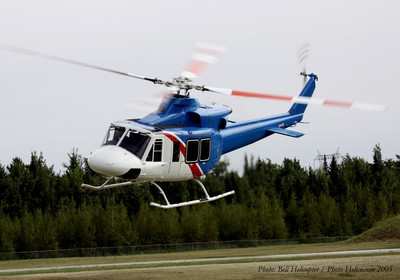Thu, Jul 22, 2010
Potential Low-Cost Option For Hover-Hold And SAR Missions
 Bell Helicopter, working in
cooperation with Esterline CMC Electronics, has developed and
flight tested a new generation GPS sensor to replace existing
high-cost Doppler or inertial velocity sensors used in automated
approach-to-hover and hover-hold systems.
Bell Helicopter, working in
cooperation with Esterline CMC Electronics, has developed and
flight tested a new generation GPS sensor to replace existing
high-cost Doppler or inertial velocity sensors used in automated
approach-to-hover and hover-hold systems.
This new product is anticipated to be available for installation
on the Bell 412EP within the next 12-months with plans to expand
availability to other models.
"The CMC GPS solution proved more responsive in flight test than
both the legacy Doppler and any of the GPS-aided inertial solutions
being examined when tied to the existing 412EP autopilot, but this
is not just for SAR and hover-hold," said Bell's chief technology
officer, Nick Lappos. "We see this technology and the capability it
brings as a means to improve safety in low-speed operations in
general as well as reduce the cost of SAR operations."
The Bell-CMC ground velocity sensor is designed to work with the
existing autopilot systems the Bell-CMC ground velocity sensor
provides law enforcement and emergency medical service (EMS)
operators with significant SAR safety enhancements at an affordable
price.

Bell 412 File Photo
This new offering will provide immediate benefit for Bell 412EP
operators by reducing weight, minimizing installation requirements,
and improving stabilized hover-hold performance. Unaffected by
glassy water, tall grass, under-slung objects or other situations,
the new Bell-CMC sensor avoids many operational constraints that
have traditionally challenged the performance of Doppler
systems.
Established as a stand-alone software upgrade to the Esterline
CMC Electronics CMA-5024 satellite based augmentation systems
(SBAS) GPS receiver, the new Bell-CMC low-cost ground velocity
sensor processes a specific property of the raw GPS signals to
produce an actual velocity measurement versus reporting changes in
GPS positions over time.
Taking advantage of the processing power and high-update rate of
the CMA-5024, and not being limited to WAAS/SBAS coverage, the
system's ground velocity function is usable world-wide.
More News
He Attempted To Restart The Engine Three Times. On The Third Restart Attempt, He Noticed That Flames Were Coming Out From The Right Wing Near The Fuel Cap Analysis: The pilot repor>[...]
Make Sure You NEVER Miss A New Story From Aero-News Network Do you ever feel like you never see posts from a certain person or page on Facebook or Instagram? Here’s how you c>[...]
From 2009 (YouTube Edition): Leading Air Show Performers Give Their Best Advice for Newcomers On December 6th through December 9th, the Paris Las Vegas Hotel hosted over 1,500 air >[...]
Aero Linx: NASA ASRS ASRS captures confidential reports, analyzes the resulting aviation safety data, and disseminates vital information to the aviation community. The ASRS is an i>[...]
“For our inaugural Pylon Racing Seminar in Roswell, we were thrilled to certify 60 pilots across our six closed-course pylon race classes. Not only did this year’s PRS >[...]
 NTSB Final Report: Rutan Long-EZ
NTSB Final Report: Rutan Long-EZ ANN FAQ: Turn On Post Notifications
ANN FAQ: Turn On Post Notifications Classic Aero-TV: ICAS Perspectives - Advice for New Air Show Performers
Classic Aero-TV: ICAS Perspectives - Advice for New Air Show Performers ANN's Daily Aero-Linx (06.28.25)
ANN's Daily Aero-Linx (06.28.25) Aero-News: Quote of the Day (06.28.25)
Aero-News: Quote of the Day (06.28.25)




